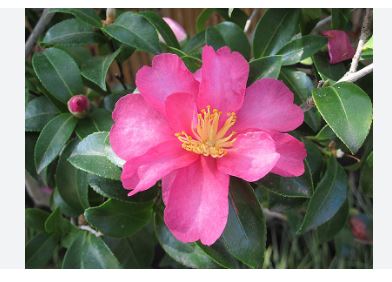
Camellia sasanqua is native to the southern regions of Japan, including Kyushu, the Ryukyu Islands, and Shikoku. It was introduced to the Western world in 1820 by Captain Richard Rawes, when he brought a variety back to England. Later, in 1869, Dutch traders introduced it to Europe. The plant has been cultivated in Japan for centuries, where it’s known as Sazanka (サザンカ). It began appearing in cultivars at the start of the Edo period, indicating its long history of cultivation and appreciation for its aesthetic qualities.
Characteristics
- Growth: It’s an evergreen shrub or small tree that can grow up to 5 meters (16 feet) tall. It’s known for its rapid growth, reaching heights of 6 to 14 feet.
- Leaves: The leaves are broad elliptic, typically 3–7 cm long and 1.2–3 cm broad, with finely serrated margins. They are glossy, dark green, and leathery.
- Flowers: Flowers are 5–7 cm in diameter, with 5–8 petals ranging from white to dark pink. They are often fragrant, single or double in form, and bloom in the autumn, which differentiates them from other camellias that bloom in winter or spring.
- Plant Behavior: Unlike the more tree-like Camellia japonica, C. sasanqua has a more open, shrub-like growth habit with branches that reach out. It’s less likely to grow as tall as C. japonica, maxing out at about half its potential height.
Cultivation
- Climate: Best suited for USDA Hardiness Zones 7-9, preferring temperatures around 60ºF to 70ºF.
- Soil: Requires well-drained, acidic to neutral soil with a pH range of 4.5 – 6.5.
- Sunlight: Thrives in full sun to partial shade. It has good resistance to full sun, unlike some other camellias.
- Watering: Regular watering is needed, especially in dry periods, but it should not be waterlogged.
- Pruning: Pruning can be done after flowering to maintain shape or size. Its open growth habit makes it suitable for espalier or informal hedges.
- Fertilization: There’s generally no need to fertilize in the spring, unlike other plants, but specific guidance might depend on soil conditions.
- Pests and Diseases: Generally resistant to the petal blight that affects other camellias due to its fall blooming period. However, it can be susceptible to twig blight and other common camellia issues.
- Uses: Besides ornamental uses for its autumn flowers and evergreen foliage, its seeds can be pressed for oil, similar to but less common than Camellia oleifera, used for cooking and cosmetics.
Cultivars
There are numerous cultivars, offering variations in flower color, form, and plant size, contributing to its popularity in landscaping for its fall and early winter interest.
- ‘Kanjiro’ (Pink Showa) – Known for its bright pink, semi-double flowers with yellow stamens.
- ‘Yuletide’ – Has bright red flowers with yellow stamens that bloom around Christmas time.
- ‘Setsugekka’ – This cultivar has large, white, semi-double flowers with fluted petals and prominent golden stamens.
- ‘Cleopatra’ – Has pink flowers that can appear almost purplish and has a more formal double bloom.
- ‘Shishi Gashira’ – A dwarf variety with semi-double to double, bright rose-pink flowers.
- ‘Jean May’ – Features shell-pink, semi-double flowers with a more pronounced fragrance than many other Sasanqua cultivars.
- ‘Mine-No-Yuki’ (Snow on the Mountain) – This one has white, semi-double to peony form flowers that can sometimes exhibit a slight pink tint under certain conditions.
- ‘Apple Blossom’ – Has single flowers that start white and blush to pink, reminiscent of apple blossoms.
- ‘Chansonette’ – Bright pink, ruffled, double flowers.
- ‘Daydream’ – Features white flowers edged with deep pink. It has a good growth rate and form for landscaping.